A UX design bootcamp is an in-depth training program that teaches the practical skills and tools needed to work in UX.
They’re cheaper than college degrees, and they’ll take you a fraction of the time to complete. But can a UX bootcamp really turn out job-ready designers that employers want to hire?
And if you do decide to take a UX design bootcamp, how can you make sure you’re investing your time and money in the right place?
In this guide, we’ll answer all your UX design bootcamp-related questions. We’ll also take you through a curated round-up of the best UX design bootcamps available in 2025. And, finally, we’ll provide a practical roadmap to help you choose the right UX bootcamp for you.
By the end of this blog post, you’ll be one step closer to starting your career as a UX designer.
Here’s what we’ll cover:
- Is the UX design field oversaturated? (2025)
- Are UX design bootcamps worth it?
- Is a UX bootcamp enough to get a job?
- What makes a good UX bootcamp?
- Which UX bootcamp is the best?
- The best UX bootcamps (2025 update)
- How do I choose the right UX bootcamp for me?
- Key takeaways
- FAQ
Want a practical introduction to UX design? Try this free UX design short course.
Is the UX design field oversaturated? (2025)
No, the UX design field is not oversaturated. In fact, the global tech industry is growing—and so is the demand for UX skills.
Gartner predicts that global IT spending will reach $5.75 trillion in 2025—a 9.3% growth rate compared to 2024.
In line with this tech industry boom, CompTIA estimates that UX and UI jobs will grow 134% faster than the overall national employment rate in the next 10 years.
With the rise of AI, rapidly advancing technology, and a huge focus on digital transformation, UX designers are more important than ever. Businesses increasingly need skilled designers who can bridge the gap between technology and customers.
That’s not to say that the UX industry isn’t competitive. Newcomers to the field must demonstrate hands-on proficiency, be confident in tackling complex challenges, and be ready to continuously learn and adapt.
This is where a UX design bootcamp can give you the edge. By focusing on practical skills and job-like scenarios, a good quality bootcamp can take you from design novice to employable UX professional in a relatively short space of time.
And when you do enter the job market, you can be confident that there are jobs waiting. The UX design field is not oversaturated; it’s still very much thriving and full of opportunities.
Are UX design bootcamps worth it?
If you want to jumpstart your career in UX design without embarking on years and years of study, then yes, a UX design bootcamp is worth considering.
But the answer to this question really depends on the quality of your chosen bootcamp. We’ll consider what makes a good UX design bootcamp in a later section. First, let’s explore the benefits of a UX bootcamp:
- Accelerated, in-depth learning: UX design bootcamps are an excellent alternative to lengthy degree programs (which can take years to complete). With a good UX bootcamp, you can train in essential UX tools, concepts, and methodologies in under a year.
- Hands-on practice and experience: The term bootcamp is synonymous with hands-on learning. You’ll be fully immersed in the topic; not just reading about UX, but actively tackling practical design challenges. This is crucial preparation for working in the field.
- Networking opportunities: Most UX bootcamps will connect you with industry experts, mentors, and peers, creating valuable networking opportunities that can open doors later on in your career.
- Job readiness: Most important of all, UX design bootcamps are focused on employability. Many bootcamps include career coaching, resume reviews, portfolio feedback, and interview prep, helping you transition into your new career path.
It’s important to do your research and choose a reputable bootcamp that aligns with your career goals, lifestyle, and learning preferences. We’ll show you how to identify the most suitable bootcamps for you towards the end of this post.
Is a UX bootcamp enough to get a job?
While a UX bootcamp can provide you with valuable skills and a portfolio, it is not a guarantee of employment.
It’s important to network, continue learning, and gain real-world experience through internships or freelance work to increase your chances of landing a job in UX design.
It’s worth noting that some UX design bootcamps (like the CareerFoundry UX Design Program) do offer a job guarantee. In such cases, you may be eligible for a refund if you don’t land a job within a certain amount of time (say, within 6 months of graduating). But this is still contingent on you being proactive about your career-change and taking steps to:
- Polish up your UX design portfolio and show employers what you’re capable of
- Grow your network and foster meaningful industry connections
- Leverage your transferable skills and emphasize your unique value on the job market
A top quality UX design bootcamp will help you with all those things. Ultimately, as long as you’re passionate and committed to your career-change, and have learned the necessary skills, you should be in a great position to land a job after completing your UX bootcamp.
On that note: what criteria should you be prioritizing when choosing a UX bootcamp? Let’s take a look.
What makes a good UX bootcamp?
There is no one-size-fits-all when it comes to finding a good UX bootcamp. Every bootcamp student has their own goals, preferences, and expectations of the overall learning experience.
However, there are certain criteria that can help you assess the quality of a UX bootcamp. In particular, look for:
- A thorough, up-to-date curriculum: A good UX bootcamp will cover the full UX design process, including user research, wireframing, prototyping, and usability testing. It should teach industry-standard tools, and it should be updated to keep pace with the industry (e.g. most up-to-date bootcamps now include an AI-related component).
- Experienced instructors and/or mentors: Course tutors, instructors, and mentors should have first-hand industry experience, offering valuable feedback, insights, and guidance around UX best practices.
- Hands-on projects: This is primarily what sets UX design bootcamps apart from free courses and independent study. Ideally, the program should emphasize project-based learning, enabling you to apply your new skills and build a professional portfolio.
- Positive reviews and alumni outcomes: The best UX design bootcamps will have a strong track record of graduates landing jobs in the field. This is one of the biggest indicators that a bootcamp is both credible and effective.
Which UX bootcamp is the best?
There is no one “best” UX bootcamp, as the effectiveness of a bootcamp can vary depending on your individual needs and goals. It’s important to research and compare different programs, read reviews from former students, and consider factors such as curriculum, duration, cost, and job placement rates before making a decision.
Still, we can help you narrow down your search. Without further ado, here’s our hand-picked round-up of the best UX bootcamps in 2025.
The best UX bootcamps (2025 update)
1. CareerFoundry

- Format: Online
- Duration: 6–10 months
- Cost: $7,505
There are few UX design bootcamps on the market that combine a comprehensive curriculum, personalized mentorship, and student-focused learning quite like CareerFoundry. Our online certified UX Designer program takes you through three journeys—Intro to UX, UX Immersion, and your choice of specialization (UI design, voice user interface design, or frontend development).
As of 2024, our curriculum has been updated to include a new focus on artificial intelligence (AI): you’ll learn to use AI critically, ethically, and in a way that is reflective of how real-world tasks are approached in the industry, while still building the core skills of your new profession.
With 96% of our eligible alumni getting a tech job within 180 days of graduation at top companies including Google, Apple, and Amazon, CareerFoundry offers some of the highest-quality course content on the scene (and a job guarantee).
For an independent review of the CareerFoundry UX Design Program, check out this video where student Cynthia talks about her experience with the course so far:
Want to learn more about how CareerFoundry can take you from a total novice to a motivated, confident UX designer? Learn more about our Full UX Design Program in this guide!
2. Chegg Skills (formerly Thinkful)
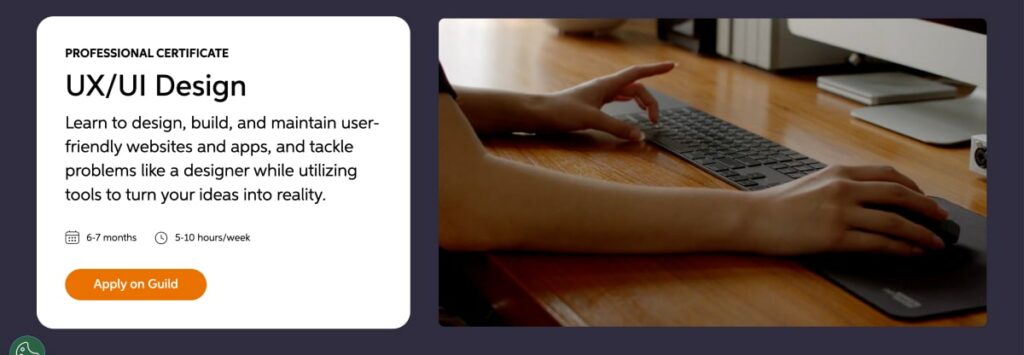
- Format: Online
- Duration: 6-7 months (5-10 hours per week)
- Cost: Price available upon application for the program
Chegg Skills (formerly Thinkful) offers a professional bootcamp covering both UX and UI design. In 6-7 months, students learn exactly what it takes to design, build, and maintain user-friendly websites and apps.
Taught at a flexible pace via the online learning platform, together with practical projects, this in-depth bootcamp explores every stage of the design process: from research and ideation through to information architecture, prototyping, and interactive design.
And, thanks to weekly check-ins with your dedicated mentor, you’ll benefit from expert support and guidance every step of the way.
3. Flatiron School
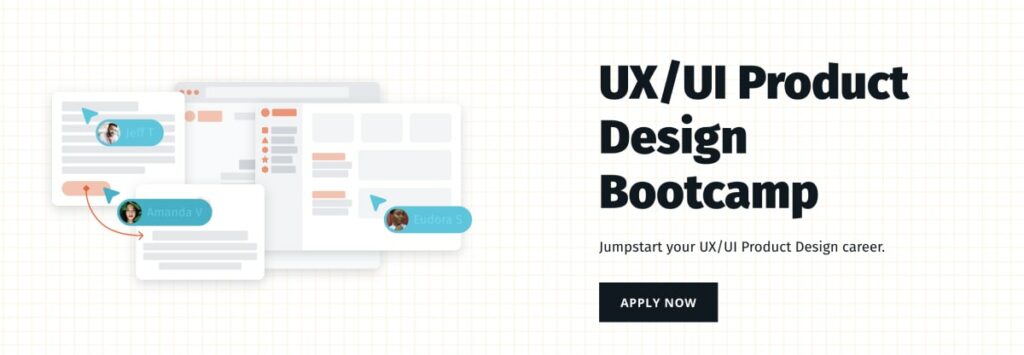
- Format: Online
- Duration: 40 weeks part-time
- Cost: $16,900
If you want a holistic design education that spans both UX and UI design, consider Flatiron School’s UX/UI Product Design Bootcamp.
Over 40 weeks, you’ll learn flexibly at your own pace. You can also attend optional study groups and office hours, and you’ll be connected with your peers on Discord.
Flatiron School is built for career-change, offering a rigorous, market-aligned curriculum, project-based learning, and support from industry experts.
4. Ironhack
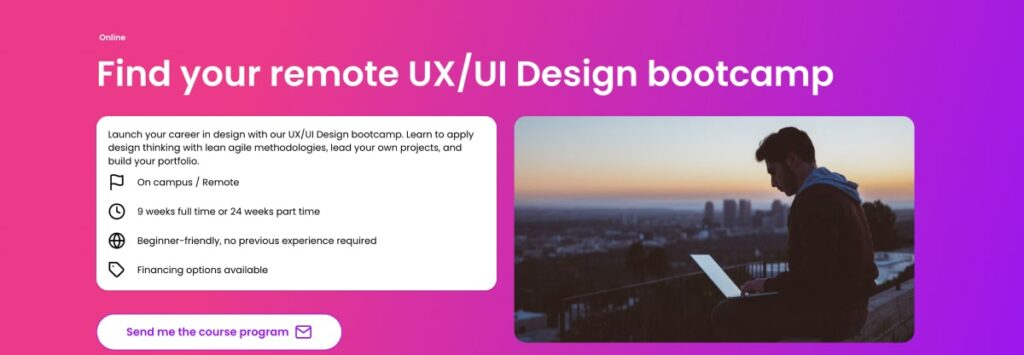
- Format: Online
- Duration: 9 weeks full-time or 24 weeks part-time
- Cost: €8,000 (approx. $8,400)
Ironhack offers a nine-week full-time UX design course or a 24-week part-time UX design course. Career services include portfolio and resume building, job interview preparation, networking, and hiring fairs.
Ironhack has set itself apart by offering scholarships available for women and military vets who are interested in a tech career.
5. Springboard
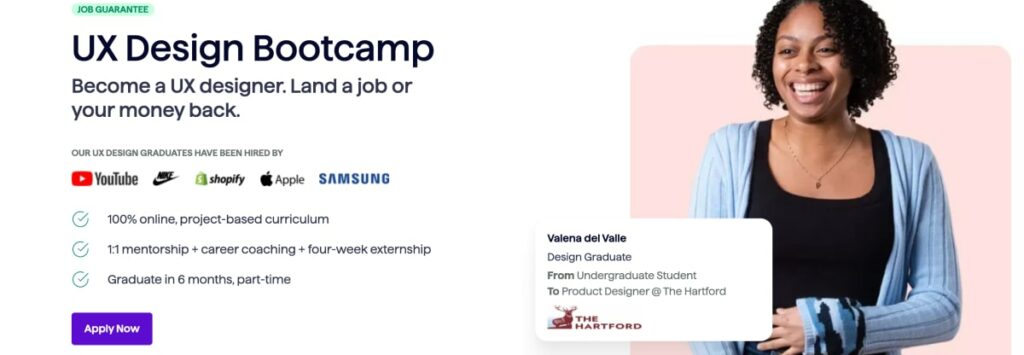
- Format: Online
- Duration: 2–4 months
- Cost: $7,900–$14,500
Springboard offers self-paced UX design courses that can be completed in 2 to 4 months. Springboard also provides a part-time UX Career Track, which boasts one-on-one weekly mentor support.
As the course is billed monthly, students who finish early have the option of paying less for their tuition.
6. General Assembly
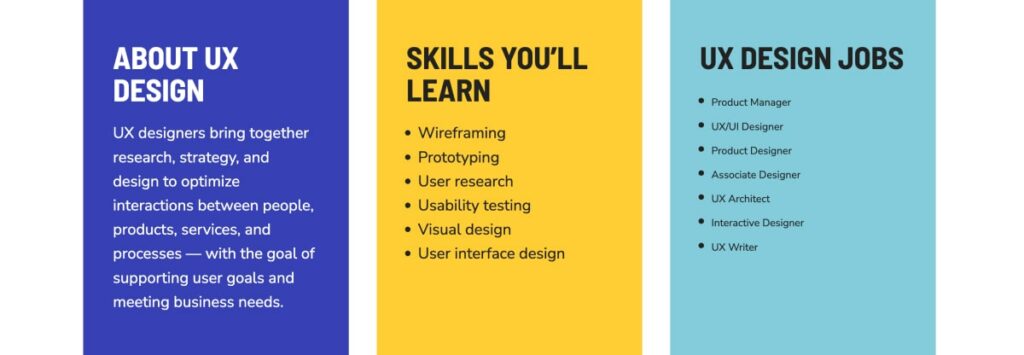
- Format: Online and in-person
- Duration: 12–24 weeks
- Cost: $15,950
Focusing on the most relevant and in-demand skills in design, General Assembly offers a range of full-time, part-time, and self-paced courses, online and in-person, across 15 campuses on 4 continents. You’re guaranteed a high-quality education, with clients and hiring partners such as Google, Microsoft, and Visa.
They also offer employer sponsorship and payment plans to help you finance the course. Students are also given a career coach and the opportunity to attend various networking events.
7. DesignLab
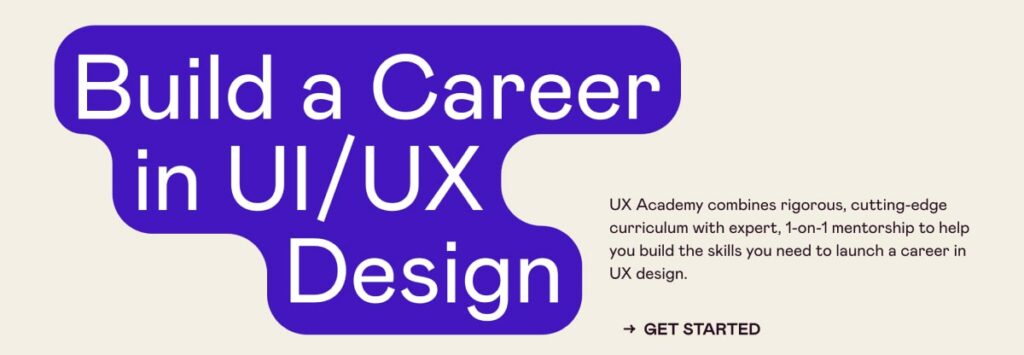
- Format: Online
- Duration: 4–6 weeks
- Cost:$7,249–9,677
Offering both full-time and part-time online courses, DesignLab teaches in-demand UX/UI design skills through self-paced learning. DesignLab provides each student with a career coach who guides the student on the job search for up to six months after graduation.
Courses consist primarily of hands-on projects and 1-on-1 mentorship from expert designers and top industry professionals.
8. Memorisely
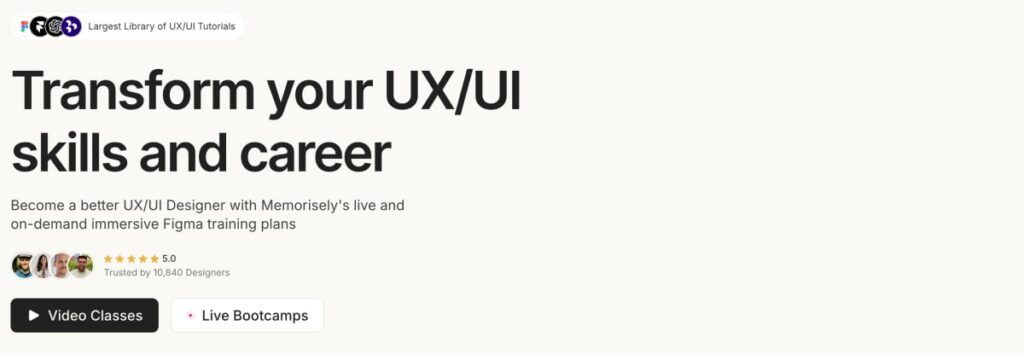
- Format: Online
- Duration: 15 weeks
- Cost: $3,950
In Memorisely’s UX/UI Design Bootcamp, you’ll be part of a small class of 15 aspiring designers in a 15-week intensive course that involves live, online meetings.
As you progress, you’ll create case studies for websites and mobile apps for real companies and develop your design portfolio.
9. BrainStation
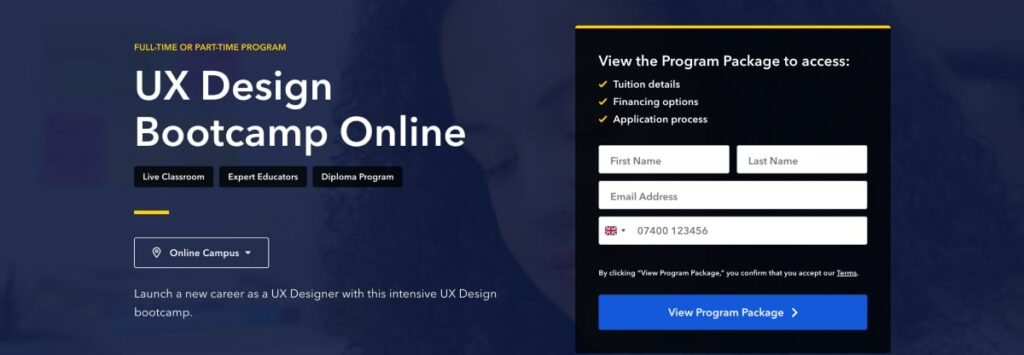
- Format: Online
- Duration: 4–9 months
- Cost: $16,500
Offered in part-time or full-time formats, BrainStation’s UX design bootcamp online includes guided, project-based learning and features guest experts throughout the program. The expansive curriculum takes the participant through all the most important facets of the user experience design world.
How do I choose the right UX bootcamp for me?
Don’t be suckered in by a five-star review—it’s essential to do your own research and take the time to consider which UX bootcamp best suits your needs.
There are two types of UX bootcamps: online bootcamps and in-person bootcamps. Some online bootcamps are flexible and self-paced, meaning you can choose your own study hours that fit around your schedule. Other online bootcamps offer set class times with virtual classrooms, taking place using video call or chat.
On the other hand, in-person bootcamps are bootcamps that take place locally in a fixed location, with fixed start dates and class times.
When choosing a UX bootcamp, here are the factors that need to be considered:
Scheduling
When looking at UX bootcamps, reflect on how many hours of study you can realistically commit to per month. If you plan to study UX design while maintaining a full-time job, you’ll likely be better suited to an online, flexibly-paced bootcamp which allows you to choose your own hours.
If you’re looking to make the switch into UX design as quickly as possible, you might be more drawn to an intensive course that will enable you to become a fully-fledged UX designer within a matter of a few months.
Curriculum quality
No two UX bootcamps are created equal: the quality of the course content makes a huge difference to how qualified you’ll be in the field of UX design. Is the curriculum curated from outside materials, or is it produced in-house by subject matter experts?
How regularly is it updated? How does the program break down what you learn within the world of UX? Is the curriculum up to speed with the latest methods, tools, trends, and software? Dive deep into each school’s curriculum to ensure it meets your standards. Above all, make sure the course content excites you!
Job practicality
Consider the current job market. In what ways will your chosen bootcamp prepare you for the job market? Does the school offer in-house career specialists who can support you throughout your job searching process? Does the bootcamp regularly update their course content to reflect current industry trends?
Does the bootcamp hold regular networking events, offering opportunities to broaden your horizons and seek out job opportunities? Is there a strong focus on ensuring you graduate with a robust portfolio that you can show to future employers and clients?
Alumni reviews
The best way to gauge whether a UX bootcamp is right for you? Connect with alumni. Find out what kind of roles and careers the students went on to do, and attend events which will allow you to connect with current students and alumni.
Hearing the stories of the people who studied with the UX bootcamp in question will help you to gauge whether it’s right for you. Try to connect with an alumnus who comes from a similar background as the field you’re currently in. Through them, you’ll get more of an insight into how your career path might look.
Add-ons
Many UX bootcamps offer additional ‘specialization courses’ to further bolster your qualifications and broaden your skillset. For example, in addition to UX design, you could do a specialization course in UI design, frontend development, and voice user interface design (VUI). These additional skills will give you a competitive edge when it comes to the job market.
Costs
Of course, it’s essential to compare the prices of different UX design bootcamps. UX bootcamps are a sizeable investment, and while the evidence shows that they are more than worth the money, it’s still worth making sure you’re getting the maximum amount of bang for your buck.
Consider looking into taking out student loans, pulling from your savings, or seeing if programs offer ways to pay the tuition fee after you land a job.
What payment options do they offer? Is there a way for you to stagger the cost of tuition? Consider your living expenses if you can’t work while doing the program.
Key takeaways
Changing your career is not easy. It involves significant risk-taking, a willingness to start from square one again, and an ability to embrace change in radical ways.
Bootcamps provide the ideal environment where ideas can flourish without boundaries, and UX hopefuls can learn, make mistakes, and discover a whole new world—free of judgment or pressure. In 3 months to a year, through intensive coursework paired with strong career support, UX hopefuls can learn user experience design inside out and front to back.
Want to learn more? Speak directly with a program advisor or read our guide on everything you need to know about becoming a certified UX designer.
Otherwise, check out these articles:
- The fascinating history of UX design
- 9 Non-design related skills you’ll need as a UX designer
- The 5 biggest differences between UX and UI design
FAQ
Are UX bootcamps worth it?
UX bootcamps can be worth it for individuals who want to jumpstart their careers in UX design or for those who are looking to expand their skillset. Bootcamps provide an immersive and intensive learning experience that can help you gain practical knowledge and build a portfolio. However, it’s important to do your research and choose a reputable bootcamp that aligns with your career goals.
Is a UX bootcamp enough to get a job?
While a UX bootcamp can provide you with valuable skills and a portfolio, it is not a guarantee of employment. It’s important to network, continue learning, and gain real-world experience through internships or freelance work to increase your chances of landing a job in UX design.
Which UX bootcamp is the best?
There is no one “best” UX bootcamp, as the effectiveness of a bootcamp can vary depending on your individual needs and goals. It’s important to research and compare different programs, read reviews from former students, and consider factors such as curriculum, duration, cost, and job placement rates before making a decision. Some popular UX bootcamps include CareerFoundry, Flatiron School, and BrainStation.
